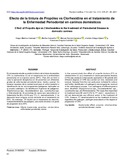Mostrar el registro sencillo del ítem
Efecto de la tintura de Propóleo vs Clorhexidina en el tratamiento de la Enfermedad Periodontal en caninos domésticos
| dc.rights.license | http://creativecommons.org/licenses/by-nc-sa/3.0/ve/ | es_VE |
| dc.contributor.author | Medina-Valarezo, Diego | |
| dc.contributor.author | Camacho, Martha | |
| dc.contributor.author | García-Herreros, Manuel | |
| dc.contributor.author | Ortega-Ojeda, Andrés | |
| dc.contributor.author | Angulo Cubillán, Francisco | |
| dc.date.accessioned | 2021-08-02T20:02:10Z | |
| dc.date.available | 2021-08-02T20:02:10Z | |
| dc.date.issued | 2021-08-02 | |
| dc.identifier.issn | 0798-2259 | es |
| dc.identifier.uri | http://www.saber.ula.ve/handle/123456789/47606 | |
| dc.description.abstract | En el presente estudio se analizó el efecto de la tintura de propóleo (TP) vs clorhexidina (C) en el tratamiento de la enfermedad periodontal en la especie canina (EPC). Para ello se llevó a cabo la aplicación terapéutica en 30 pacientes con diferentes grados de enfermedad periodontal (leve, media y grave). Se tomaron muestras de la cavidad bucal para el cultivo posterior e identificación de los microorganismos patógenos implicados en el proceso patológico. Se identificaron 4 géneros de patógenos: Staphylococcus spp., Corynebacterium spp., Lactobacillus spp. y Enterobacterias. El porcentaje de casos que respondieron al tratamiento fue 80 y 3,4 % para TP y C, respectivamente. C no demostró tener ninguna acción eficiente en el tratamiento de EPC. Sin embargo, TP mostró ser el tratamiento de elección, independientemente del patógeno, asociación de éstos o el grado de progresión de la EPC. | es_VE |
| dc.language.iso | es | es_VE |
| dc.rights | info:eu-repo/semantics/openAccess | es_VE |
| dc.subject | Efecto bactericida | es_VE |
| dc.subject | propóleo | es_VE |
| dc.subject | clorhexidina | es_VE |
| dc.subject | enfermedad periodontal | es_VE |
| dc.subject | canino | es_VE |
| dc.title | Efecto de la tintura de Propóleo vs Clorhexidina en el tratamiento de la Enfermedad Periodontal en caninos domésticos | es_VE |
| dc.title.alternative | Effect of Propolis dye vs Chlorhexidine in the treatment of Periodontal Disease in domestic canines | es_VE |
| dc.type | info:eu-repo/semantics/article | es_VE |
| dcterms.dateAccepted | 25/05/2021 | es |
| dcterms.dateSubmitted | 21/08/2020 | es |
| dc.description.abstract1 | In the present study the effect of propolis tincture (PT) vs chlorhexidine (C) as a treatment of canine periodontal disease (CPD) was analysed. A therapeutic application in 30 patients with different degrees of CPD was carried out (low, moderate and severe). Samples from the oral cavity were collected for culture and further identification of pathogenic microorganisms involved in the pathological process. Four pathogens of different genera were identified; Staphylococcus spp., Corynebacterium spp., Lactobacillus spp. and Enterobacterias. The cases that responded to treatment were 80 and 3.4 % for PT and C, respectively. C did not demonstrate any efficient action in the treatment of CPD. However, PT demonstrated to be the treatment of choice regardless the pathogen, pathogen associations or the degree of progression of CPD. | es_VE |
| dc.description.colacion | 81-85 | es_VE |
| dc.description.email | diego.medina@ute.edu.ec | es_VE |
| dc.description.email | francisco.angulo@fcv.luz.edu.ve | es_VE |
| dc.identifier.depositolegal | pp199102ZU46 | es |
| dc.identifier.edepositolegal | pp199102ZU46 | es |
| dc.identifier.eissn | 2477-944X | es |
| dc.publisher.pais | Venezuela | es_VE |
| dc.subject.institucion | Universidad del Zulia (LUZ) | es_VE |
| dc.subject.institucion | Universidad de Los Andes (ULA) | es_VE |
| dc.subject.keywords | Bactericidal effect | es_VE |
| dc.subject.keywords | propolis | es_VE |
| dc.subject.keywords | chlorhexidine | es_VE |
| dc.subject.keywords | periodontal disease | es_VE |
| dc.subject.keywords | canine | es_VE |
| dc.subject.publicacionelectronica | Universidad de Los Andes (ULA) | es |
| dc.subject.seccion | Revista Científica: Medicina Veterinaria | es_VE |
| dc.subject.tipo | Revistas | es_VE |
| dc.type.media | Texto | es_VE |
Ficheros en el ítem
Este ítem aparece en la(s) siguiente(s) colección(ones)
-
Revista Científica - 2021 - Vol.XXXI - Nº 003
Julio - Septiembre 2021


